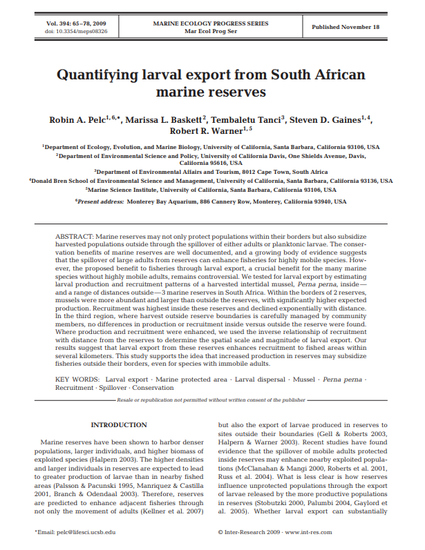
Article
Quantifying larval export from South African marine reserves
Marine Ecology Progress Series
(2009)
Abstract
Marine reserves may not only protect populations within their borders but also subsidize harvested populations outside through the spillover of either adults or planktonic larvae. The conservation benefits of marine reserves are well documented, and a growing body of evidence suggests that the spillover of large adults from reserves can enhance fisheries for highly mobile species. However, the proposed benefit to fisheries through larval export, a crucial benefit for the many marine species without highly mobile adults, remains controversial. We tested for larval export by estimating larval production and recruitment patterns of a harvested intertidal mussel, Perna perna, inside—and a range of distances outside—3 marine reserves in South Africa. Within the borders of 2 reserves, mussels were more abundant and larger than outside the reserves, with significantly higher expected production. Recruitment was highest inside these reserves and declined exponentially with distance. In the third region, where harvest outside reserve boundaries is carefully managed by community members, no differences in production or recruitment inside versus outside the reserve were found. Where production and recruitment were enhanced, we used the inverse relationship of recruitment with distance from the reserves to determine the spatial scale and magnitude of larval export. Our results suggest that larval export from these reserves enhances recruitment to fished areas within several kilometers. This study supports the idea that increased production in reserves may subsidize fisheries outside their borders, even for species with immobile adults.
Keywords
- Larval export,
- Marine protected area,
- Larval dispersal,
- Mussel,
- Perna perna,
- Recruitment Spillover Conservation
Disciplines
Publication Date
November 18, 2009
DOI
10.3354/MEPS08326
Citation Information
Robin A. Pelc, Robin A. Pelc, Marissa Leanne Baskett, Tembaletu Tanci, et al.. "Quantifying larval export from South African marine reserves" Marine Ecology Progress Series Vol. 394 (2009) p. 65 - 78 Available at: http://works.bepress.com/robin-pelc/3/
